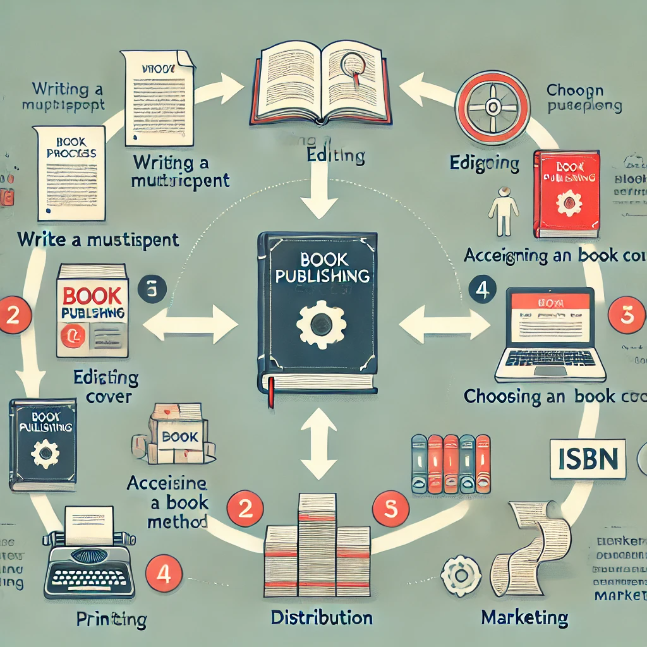Steps in Book Publishing: A Comprehensive Guide

Publishing a book is an exciting and rewarding journey that transforms your written manuscript into a tangible product ready for readers around the world. Whether you are an aspiring author or a seasoned writer, understanding the steps involved in book publishing can help you navigate the process more effectively. Here is a comprehensive guide to the steps in book publishing.
1. Writing the Manuscript
The first step in book publishing is writing your manuscript. This is the foundation of your book and requires careful planning, creativity, and dedication. If you need guidance on how to write a book, refer to our Comprehensive Guide for Aspiring Authors. This guide will provide you with detailed tips on outlining, drafting, and revising your manuscript to perfection.
2. Editing and Proofreading
Once your manuscript is complete, the next step is editing and proofreading. This process involves:
- Self-Editing: Reviewing your work for any obvious errors or inconsistencies.
- Professional Editing: Hiring a professional editor who can provide a thorough critique and suggest improvements in structure, style, and content.
- Proofreading: Ensuring that your manuscript is free from grammatical, punctuation, and typographical errors.
Editing and proofreading are crucial for producing a polished and professional book.
3. Designing the Cover and Layout
A book’s cover is often the first thing potential readers notice. A well-designed cover can attract attention and convey the essence of your book. Consider hiring a professional graphic designer to create a compelling cover. Additionally, the interior layout should be formatted correctly to ensure a pleasant reading experience. This includes:
- Typography: Choosing the right fonts and font sizes.
- Page Layout: Setting margins, line spacing, and paragraph styles.
- Images and Illustrations: Placing any images or illustrations appropriately within the text.
4. Acquiring an ISBN
An International Standard Book Number (ISBN) is a unique identifier for your book and is necessary for distribution and sales. You can purchase an ISBN from your country’s ISBN agency or receive one from your publisher if you are working with a traditional publishing house.
5. Choosing a Publishing Method
There are several publishing methods to consider:
- Traditional Publishing: Submitting your manuscript to publishing houses and literary agents. If accepted, the publisher handles the production, distribution, and marketing.
- Self-Publishing: Independently publishing your book through platforms like Amazon Kindle Direct Publishing (KDP), IngramSpark, or Smashwords. This method gives you more control but also requires you to handle many aspects of the publishing process.
- Hybrid Publishing: A combination of traditional and self-publishing, where you might pay for certain services like editing and marketing, but retain more control and higher royalties.
6. Printing and Distribution
If you choose to publish a print version of your book, you will need to decide on the printing options:
- Print-on-Demand (POD): Books are printed only when an order is placed, reducing the need for inventory.
- Offset Printing: Bulk printing that can be cost-effective for larger print runs.
For distribution, you can use services like Amazon, Barnes & Noble, or independent bookstores. Digital versions of your book can be distributed through eBook platforms.
7. Marketing and Promotion
Marketing is essential to get your book noticed by potential readers. Here are some strategies:
- Author Website and Blog: Create a professional website where readers can learn more about you and your book.
- Social Media Marketing: Use platforms like Facebook, Twitter, and Instagram to promote your book and engage with readers.
- Book Launch: Plan a book launch event, either in-person or virtual, to create buzz around your book’s release.
- Book Reviews: Reach out to book bloggers and reviewers to get reviews and endorsements.
- Paid Advertising: Consider investing in paid ads on social media or book promotion sites to increase visibility.
8. Continuous Engagement
After your book is published, continue to engage with your audience. Respond to reader feedback, participate in book signings and author events, and keep promoting your book. Building a loyal reader base is key to your long-term success as an author.
Conclusion
Publishing a book involves multiple steps, from writing and editing to marketing and distribution. By understanding and carefully executing each step, you can successfully navigate the publishing process and bring your book to a wide audience. For more detailed guidance on writing your book, check out our Comprehensive Guide for Aspiring Authors. Happy publishing!



